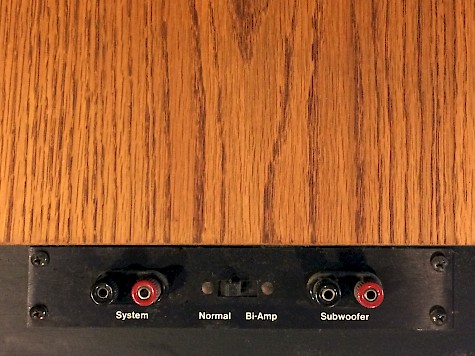A King of the Classic Box Speakers From Audio’s Golden Age.
Well, boys and girls, once upon a time there was the “Dark Age of Audio.” Music in the home was reproduced by things called Victrolas, Gramophones and other names, all had a turntable spinning at somewhere around 78 rpm – the speed was never all that accurate and it didn’t matter all that much because the music was recorded to be played at something close to that speed. The records were mostly 10 and 12-inch discs referred to as “shellac,” but, of course, they were not really made from shellac.
They were, however, fragile. A symphony required a group of two-sided discs – break one and the entire piece of music was gone. A needle that was, in fact, pretty much like a needle and fastened in place by a screw traversed the grooves in this shellac record. Listeners kept a supply of needles near the record player and replaced them periodically.
In the late 1940s, the advent of the stereo LP, or Long Playing record, changed everything and brought light to the musical world.
Enter the Golden Age
The Golden Age of Audio was ushered in with AR’s acoustic suspension speakers producing good bass from small boxes. They were driven by the new high-powered (up to 75 watt) tube amplifiers playing stereo LPs. The Golden Age faded with the introduction of CDs, DVDs and ended with ‘Home Theater in a Box’ and MP-3s thru earbuds. During the Golden Age speakers also made progress. Most became optimally-vented speakers producing more and deeper bass from smaller drivers and boxes. The Japanese produced monster AM-FM receivers with hundreds of watts. This was the peak of the Disco Era and Reggae Invasion. “Loud is Beautiful” was even one speaker manufacturer’s (Cerwin-Vega) motto. Although many exotic designs and materials were used in speakers during this period (like Walsh drivers, Heil AMT drivers, planar magnets, and electrostatics) the box speaker designs dominated the sales. The Ohm I (the letter – not the number) pushed the limits of box technology.
The Ohm I’s cabinet was a compact, floor standing design of a little over 15” square near the bottom tapering to 13” square at the top (34” above the floor). This allowed it occupy about the same space as a full-sized bookshelf speaker mounted on the appropriate stand. It was quite small for its tremendous output ability.

Most of the cabinet was devoted to the 12” vented subwoofer driver. Subwoofers were all passive in those days or required external electronic crossovers and separate power amplifiers. In fact, we introduced the Ohm I to the consumer market before most people had even heard of a subwoofer. We designed ours to have the option to work with an external powered crossover, or, by means of a switch, to run in parallel with the rest of the system off of the output of a regular 2-channel stereo amp. The 5” diameter vent could produce more bass than any 18” acoustic suspension woofer of the day. With the 32 Hz low frequency cut-off we were aiming for, the vent had to be only 9” long. We designed the woofer to have a natural roll off about 90 Hz so no low-pass crossover was required. The subwoofer driver was connected directly to the amplifier to get the best control and maximum output.
The top part of the cabinet included the woofer, low tweeter and two super-tweeters. This section was also vented to get extra output from the 8” woofer. The vent tuning and high-pass crossover allowed the subwoofer and woofer to mate nearly perfectly from any listening position. This eliminated the placement problems that still plague subwoofer/mains today. The crossover from the woofer to the tweeter is always a problem because the dispersion of the woofer is much narrower at the crossover point than the dispersion of the tweeter. We solved this dilemma by putting them both on top of the cabinet and enjoying and identical 360-degree horizontal dispersion from both (and the subwoofer, too). Because the dispersion at the high end of the super-tweeters also narrows, we installed one on top of the cabinet to mate with the low-tweeter and one on the front to provide the metallic ‘tinkle’ of cymbals, triangles and other metallic percussion instruments. The system was rated for amplifiers up to 1000 watts per channel – about as big as you could get at the time. The Ohm I could really rock!

The Ohm I Does Its Thing…Loudly and Well
When we presented them in a sound-proof room at the 1978 Consumer Electronics Show (CES), the Ohm I demonstration was even louder than the Cerwin-Vega room according to a reviewer walking the show with a Sound Pressure Level (SPL) meter hanging around his neck. A popular demo at our factory was removing the grill, using a bridged Crown DC-300 on each Ohm I and blowing out candles (with smoke-rings) from fifteen feet across the room on the cannon shots in the Telarc 1812 Overture!
Over the years we have developed upgrades for the Ohm Is that can allow them to play deeper and be more reliable (they were not happy with distorting amplifiers – period). They were a great value when introduced and they’re still a bargain when you find used ones available. We can fix or upgrade everything (except the cabinets) so you can restore to the throne “The King of the Classics” and enjoy your music both LOUD and accurately reproduced – and, of course, live happily ever after.
Enjoy,
John
Subscribe to Ohm News & Views to get the latest posts in your inbox
John Strohbeen Author
John Strohbeen was the President and Chief Engineer of Ohm Acoustics from 1978-2023.



